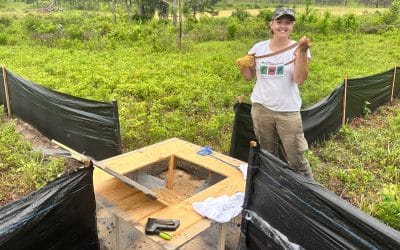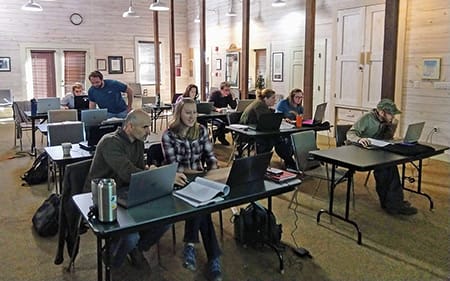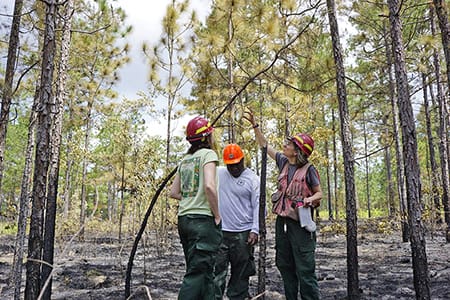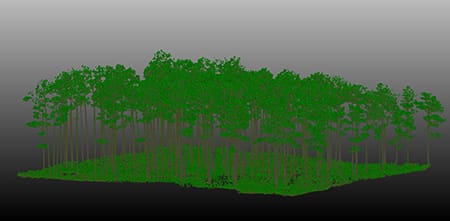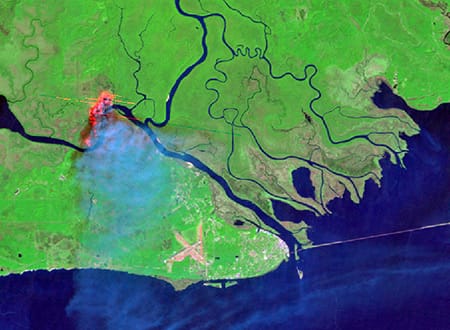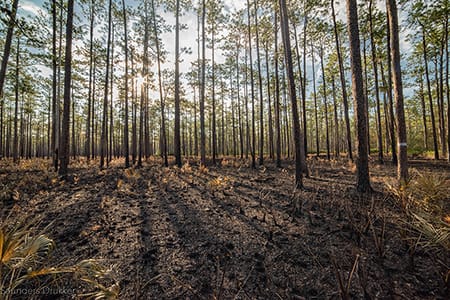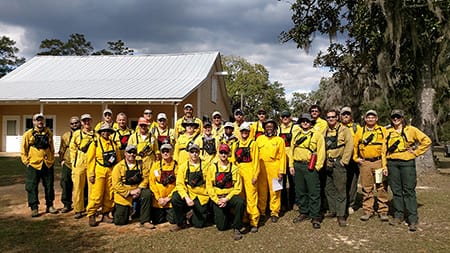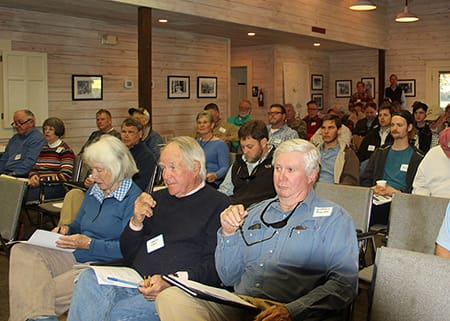Imagine if you were tasked to develop an experiment on the cultural, economic and ecological effects of frequently burning large landscapes. A daunting task at first, but with a bit of planning you’d likely be able to wrap your head around it.
First you would have to decide on the size of the landscape needed for the experiment. Ten thousand acres seems way too small a scale; 100,000 acres at minimum would be needed to capture the dynamics of the wildlife, ecology, and people. You land on closer to a half-million acres as a minimum area needed to run the experiment, and to fully capture the dynamics.
What about the length of the experiment? A decade is not enough time to let fire do its work on the vegetation, soils, and wildlife. Probably at least 30 years for fire to change the vegetation and soils and wildlife, and to effect timber and agriculture and waterways; maybe more like 50 years would be needed, or 100? It would take a bit of time, and you would need the landowners in the region to agree to the experiment and to allow their lands to be burned. You would also need to budget for a pile of fire practitioners to put in the fire breaks and conduct the burning, not to mention the equipment and people to measure the outcomes.
To be realistic it would need to interface with rural and urban communities to assess the human dimension side of the study — smoke management and society’s willingness to participate in a fire-maintained ecosystem. The experimental design and proposal would no doubt be thought a masterpiece! It would be a collection of ideas that once accomplished would provide relevant and needed information on the impact of prescribed burning to the world.
Considering the need for and value of this information, a billion-dollar budget shouldn’t raise anyone’s eye-brows considering the Apollo space program cost $26 billion (in 1960 dollars). But, perhaps this is just smoke and no fire — for finding the time, space, willing landowners, and resources to complete this experiment — it may be impossibly difficult. Fortunately for us, this “100-year experiment” has already been completed; in fact, it is on its second 100 years — with no end in sight.
A Landscape Managed with Fire
Since the Pleistocene, there are only a handful of places on earth where frequent fire has never left the landscape. One of these rare gems is the quail properties of the Red Hills of Georgia and Florida. Here, fire has been a land use practice since people first traversed the landscape some 14,000 years ago. Taking over what nature provided in the form of lightning set fires, indigenous people used fire for hunting, clearing, agriculture, and Europeans and Americans for ranching and forestry, and now again — hunting. Over the last 135 years or so, sportsmen and women have managed the landscape with fire. Through this span of time, each intentional fire was lit by someone, unknowingly perhaps, but happily collaborating in the 100-year experiment.

Dixie Crusaders ca. 1920s. Courtesy of the American Forests Archives.
Consider that fire was a cultural practice across the United States, and world, even into the 1950s in some places. However, a combination of factors, mostly after the 1920s, began to reduce rural communities use of controlled burning across the Southeast. The Dixie Crusaders funded by the U.S. Forest Service roamed through rural southern communities teaching that prescribed fire was damaging our forests, practiced by the uneducated, and needed to be stopped. On the rangelands of central Florida, Bahia grass was introduced in 1913 — a sod forming grass less reliant on fire than native grasses for raising cattle. Across the upper south, cool season grasses like fescue were being introduced to ranchers and farmers — a completely fireless grassland.
The herbicide 2-4D was first introduced in 1944, and soon after came other herbicides that, along with fertilization, mechanization, and genetics fueled the green revolution in agriculture. The timber industry relied on prescribed burning for site preparation and vegetation control into the 1980s, but soon after, systems of “Total Control” and improved genetics became the recipe taught to foresters. Quickly the use of controlled burning all but disappeared from rural communities across the country.
At the same time on our public lands, “let it burn” and prescribed burning philosophies were replaced by suppression policies. All the forces of society seemed to be largely working against the use of fire as a land management tool. The only resistance was coming from a few places — Tall Timbers among them. Through these changes, the 100-year experiment was very quietly carry-ing on. People in the Red Hills weren’t boasting about it; it was just their way.
At first, it was a fascination about how to manage for bobwhites that drove Herbert Stoddard and the landowners who funded his study. His landmark study on bobwhites helped keep fire on the landscape of the Red Hills and Albany regions, but soon morphed into much more than just for quail. Stoddard also was fascinated by how low-intensity prescribed fires sustained the diversity evolved to cope with, and more often than not, benefit from fire. He found that fire was critical to growing a superior timber product, while maintaining the native ecosystem. As early as 1959, he set up experiments on Tall Timbers to demonstrate how important frequent prescribed burning was, but he had been contemplating it for nearly three decades. (Stoddard called for the need for an independent fire research center in his book on bobwhites published in 1931). “Calling the shot” on how the country was headed for severe wildfire problems, Stoddard and his colleagues knew what was to come. His genius, foresight and warnings would not be fully appreciated, expect by a few foresters and biologists, for nearly 80 years.
There is a reason there are few 100-year experiments, the biggest reason being scientists have a 60ish-year professional life span. However, the passion for wild quail hunting has helped to maintain a strong interest in applying frequent fire. So, despite the many scientists that have come and gone, the experiment continues. And, every experiment has response variables, those characteristics of interest that are measured in response to the treatment being applied. In this case, if you compare the Red Hills to other forested ecosystems across the country at the 500,000-acre scale over the past 100 years, the trends are clear.
In the Red Hills, fire can be used year-round and burning can occur under almost any conditions (even in light rain in some systems), because the fuels are light but flammable. Equipment needed to burn is minimal, again because of low fuel loads. With frequent fire, the Red Hills has maintained high biodiversity in the soils, vegetation, and wildlife communities. The Red Hills has the only remaining huntable wild quail population of this scale in the eastern U.S., and the largest red-cockaded woodpecker population on private lands. Water quality of our rivers and streams is high, along with a high level of water recharge to the aquifer. Carbon storage is high and the frequent prescribed fires have a neutral carbon footprint — that is the forests sequester what they release during a burn. There has not been a wildfire of note over the course of the 100-year experiment. In the Red Hills, when there is an escape from a prescribed fire, or a rare wildfire, it is contained within a few acres. When quail lands are managed for longleaf and other pines, they produce high quality timber products for generations, without losing the forest cover.
NB66: A Large-Scale Fire Exclusion Experiment on Tall Timbers
NB66 was designed to document succession in plant and animal communities on a previously annually burned pine ridge after fire exclusion on a large scale.

NB66, the large-scale fire exclusion experiment area on Tall Timbers, in March 1967. Photo by Roy Komarek.

NB66 photographed in February 2003 from the same point it was photographed in March 1967 by Roy Komarek. The X marks the same tree in each view. The 23.3-acre plot has not been burned since the winter season of 1966-1967. Photo by Todd Engstrom. Photos from Tall Timbers Archives.
The cultural response to prescribed burning
The cultural response variables may be the most fascinating of them all. State and local governments fully support the safe use of prescribed fire, and have developed training and permitting systems that help people burn; they do not hinder the use of fire. And, the public donates to non-profits that study the use of prescribed fire and its benefits! On the daily news programs, weather forecasters discuss if it is a good “burn day” and let communities know if they may or may not smell smoke in the air that day. Teachers at the local schools educate students on why prescribed fire is beneficial. State legislators have knowledge of the importance of prescribed fire, and sustain public policy to support it. On public lands, fire is used to reduce dangerous fuels that could build up and cause wildfires, and also to sustain biodiversity and outdoor recreation. Prescribed fires are set on the edges of towns to protect those towns.

A map of burn permit data shows how much prescribed fire is used in the Red Hills region (red circle), versus other private lands. Map is from the Geospatial Lab at Tall Timbers.

Relative population trends of Bachman’s sparrows and northern bobwhite quail on Tall Timbers in the Red Hills region versus the southeastern coastal plain breeding bird survey data. The data were scaled to start at the same point. Red lines represent the Red Hills, the black lines the coastal plain. Top line is Bachman’s sparrow and the bottom lines are quail.
Contrast this to the same response variables of any other 500,000-acre forested landscape that has not been maintained by frequent fire — the results are clear. You don’t even need a p-value to help determine the answers. The data show that game birds and songbirds, reptiles and butterflies have all declined severely on these landscapes. Erosion and runoff reduce water recharge and water quality. Forest and rangeland fuels have built up to make burning difficult without serious planning and expensive equipment. The season of fire is reduced be-cause of high fuel loads, making it harder to implement fire. The backlog of prescribed fire encourages larger sized fires, which have less value for sustaining biodiversity and wildlife.
While carbon sequestration of these systems can be high, if they do catch fire, they are threatened by complete combustion, soil sterilization, soil erosion, and even desertification. Worst of all, when a prescribed fire escapes, or wildfire occurs, the result is large areas that are uncontrollably destroyed — threatening people and their homes. Culturally, fire is considered a threat, and a problem. Communities suffering extreme air quality problems from the smoke that wildfires have caused have little patience for smoke from a prescribed fire. State and local agencies have a defensive posture towards prescribed fire, with a focus on suppression and tightly controlled permitting systems. It is a negative feedback loop that is only now beginning to be broken.

Herbert L. Stoddard, Sr. Photo by Wallace B. Grange, Tall Timbers Archives
When Herbert Stoddard was hired to study bobwhite quail ecology and management, he had an inkling of where to first strike. He had knowledge from watching with a keen eye towards, and passion for, ecology and wildlife. He helped make the case for continued use of prescribed fire in the Red Hills region that continues today, 100 years after he grew up in Central Florida and first saw fire used on the land. The lessons from the experiment he helped devise, and that landowners and managers of the Red Hills and Albany regions implemented, are now seen as the path forward for much of the country.
Stoddard and the residents of the Red Hills have shown in their quiet and respectful manner that there is a better way to manage our forests.
When you sit back and consider the 100-year experiment, so many things come to mind — how the rare ingredients of this study came together, and how it was largely free to society. It now seems they are listening.







